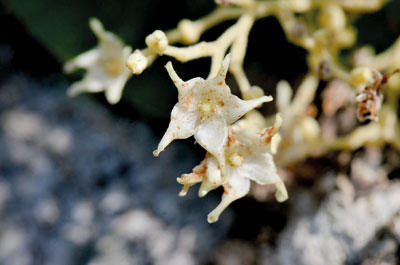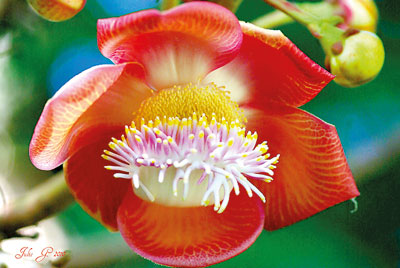News
Real Sal blooms thrive despite the ‘cannon ball’

In full bloom: The real Sal flower at the botanical gardens, Peradeniya. Pic courtesy Peradeniya Gardens
The flower with pinkish fleshy petals and strong fragrance regarded as ‘sal’ is a favourite flower of the Buddhists. But they are not aware of its real identity.
While Vesak is only few days ahead, the real sal trees in Royal Botanical Gardens, Peradeniya are in bloom. According to botanical gardens sources, the trees start flowering in early April and still there are unopened buds on higher branches. So, it is likely they will be flowering closer to Vesak and you may still have a chance to witness the real sal, in the gardens.
‘Sal’ is sacred to Buddhists as legend has it that Prince Siddhartha was born in a garden of sal trees in Lumbini and His Parinirwanaya occurred in Kusinara again under sal trees. Vesak commemorates the Birth, Enlightenment (Buddhahood), and Death (Parinirvana) of the Gautama Buddha, so it is interesting that a flower associated with two notable events bear flowers closer to the period of Vesak.
However, the real sal is a small white flower that blooms in a tree scientifically called as shorea robusta. Though these flowers are smaller and has no fragrance, there is indeed some sacredness in its appearance.
But then what about the large pink flower with a strong fragrance that we commonly know as sal?
The pink flower blooms in the cannon ball tree (couroupita guianensis). While the real sal tree is native to India/Nepal, the imposter is native to South America according to botanists. The cannon ball tree bears large rounded fruit that resembles a ‘cannon ball’.
Dr Siril Wijesundara – botanist and the former director general of Botanical Gardens Department says that the first sal tree has been planted in the Royal Botanical Gardens in 1880, but sal trees had existed elsewhere in Sri Lanka before that. He recalls there are about seven sal trees in the gardens.
The real sal tree, shorea robusta, belongs to a family called dipterocarpaceae to which the ‘hora’ trees belong to. The sal tree can grow up to 35 metres and a girth of about 2 to 2.5 metres in about 100 years under favourable conditions according to botanists. Sal is also a popular timber tree in Asia. Like hora, the fruit of shorea robusta has tiny wings to assist its distribution in the wind.

The flower misidentified as Sal
The flower misidentified as sal, has pinkish fleshy petals and a strong fragrance. The large flower is about 6 centimetres wide and has a hood-like bulge which conceals a small white nodule in the centre of the flower that looks remarkably like a small stupa. Up in the hood, there are finger like structures, which some see as deities worshipping the stupa. So, the imposter tricks the unwary Buddhists to think it is the real sal flower. The tree doesn’t have any timber value.
Dr Wijesundara also pointed out that Buddhists in Thailand too regard the wrong flower as the sal flower. Tracing back the history of the misidentification, Dr Wijesundara pointed out that in 1901 King George VI planted a cannon ball tree in the Peradeniya gardens and it was identified as couroupita guianensis, meaning that this mistake was not detected. Dr Wijesundara recalls seeing a mural by S.P. Charles at Colombo Museum, which featured the wrong tree. So he believes the mistake could have occurred later.
More mistakes continued.
To mark the peace talks of 2002, the tree planted at Rose Garden Hotel by Anton Balasingham, and Professor G L Pieris, was also the wrong sal plant.
Even in movies portraying the life of the Buddha, the cannon ball tree has been seen.
Prof Namal Gunathilake – another veteran botanist, shares an incident where the mistaken identity of real Sal tree caused trouble. At an Ayurvedic conference, one research team that tested an Ayurvedic recipe reported that the combination of medicinal compounds doesn’t work. But when Prof Gunathilake queried about the compounds they used, it was revealed that they used the barks of the wrong tree.
Sunil Sarath Perera – a song writer and a pioneer environmental activist said that the sal tree is recorded in history. The Salalihini Sandeshaya which has been written during the Kotte era has referred to sal trees and the Dutch Thombu clearly mentioned ancient village names referring to sal. Mr Perera said that Salpita Korale where he was born is such a name and in Kirulapone villages such as ‘palle pattuwa’, the name refers to the location of sal trees.
Mr Perera has also seen the aesthetic side of sal forests in India. “In north India there are stretches of sal forests. With its ivory colour flowers and less undergrowth, the sal forests are tempting for anybody to rest under their shade. He says it is not surprising that Queen Mahamaya decided to rest in a sal forest. During his three-week stay in Jim Corbett National Park, Mr Perera had visited the jungle, riding on elephants in search of royal bengal tigers.
The Botanical Gardens Department in 2012 under the guidance of Dr Wijesundara distributed about 900 sal saplings to temples around Sri Lanka.
Meanwhile, the fragrant, beautiful cannon ball flower qualifies for religious offerings.
| Climate change affects sakura blooms In Japan, the blossoming season the sakura or cherry blossoms, is slowly coming to a close. The season starts in March and lasts until early May when cherry trees in different regions come into full bloom on different dates. Having analysed the dates of these blooms in Kyoto in Japan since 800 AD, Japanese scientists have found that the sakura is blooming earlier. They worry that this is a result of global warming, where a warmer March stimulates the trees to bloom early. |

